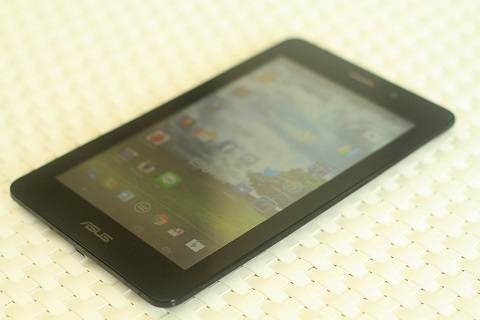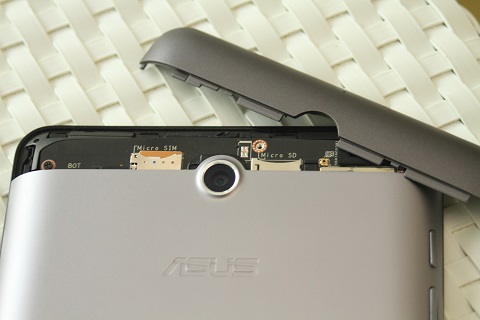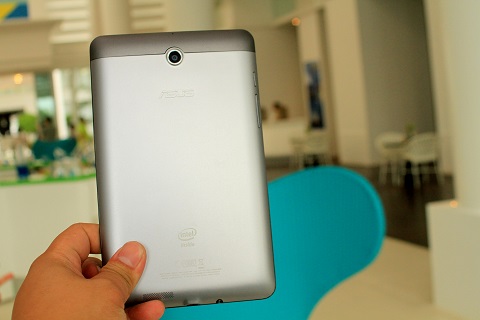We’re here at Mactan, Cebu to witness the local announcement of the tablet that has been getting a lot of attention since its debut in this year’s Mobile World Congress. Folks we’re talking about the tablet with phone capabilities, the ASUS FonePad.
Majority of the front portion is occupied by the 7-inch display and just have enough room to fit the earpiece, 1.2MP camera and its sensors. Just like its Vanilla Android-touting counterpart, ASUS also forgoes the use of physical or capacitive buttons on the front of the FonePad and instead opted for an on-screen buttons for Home, Back and Menu.

There are only three buttons on this tablet which are all placed at the top left hand side of the device. The pair sitting closely to each other is the buttons for volume, and slightly above it is the Power/Sleep/Wake button. We noticed that the keys on the demo unit is already flushed probably due to wear and tear. However, considering that the unit is fairly new as it was just recently announced in Barcelona, it may be sign of keys’ inability to withstand heavy presses.
When viewed head on, the Asus FonePad may give an impression that it’s just a typical plastic slab. However, flip the tablet on its back and you’ll notice an elegant aluminum back plate complemented by a slightly off colored removable plastic cover which hides the the MicroSIM and MicroSD card slots. The 3.15MP snapper is placed dead center at the top portion of the tablet.

The bottom half of the device’s posterior plays host to a small speaker. Keeping it company is a pair of ports for audio and MicroUSB is situated at the bottom portion of the tablet.
Although the FonePad isn’t exactly the thinnest or the lightest of the lot, its 10.4mm frame and reassuring heft of 12-ounces provided a rather comfortable grip. Moreover, the tablet is fashioned to have a good center of gravity which makes it easier to hold.
ASUS FonePad specs:
7” WXGA IPS touchscreen display, 1280×800 @216ppi
1.2GHz Intel Atom Z2420 single-core processor
PowerVR SGX540 GPU
1GB RAM
8/16GB internal storage
MicroSD card slot w/ support for up to 32GB
HSPA+
WiFi 802.11 b/g/n
Bluetooth 3.0 w/ A2DP
GPS w/ A-GPS, GLONASS
3.15MP autofocus camera
1.2MP front-facing camera
Non-removable 4270mAh Li-Ion battery
Android Jelly bean
Dimension: 196.4 x 120.1 x 10.4 mm
Weight: 340g
As far as design is concerned, we can definitely say that the Asus Fonepad is one of the more good looking 7-inchers in recent memory. The combination of simple layout plus the aluminum make of the back plate not only makes it pleasing to the eye, but also adds a sturdy appeal to it. Unfortunately, the same cannot be said for the ports on the side, which may present some concern for users in the long run.

Asus has yet to announce the local pricing and availability of the FonePad. It’s current SRP outside of our homeland is slated at USD249. We’ll make a follow up story about the other components of this tablet, including initial benchmark results and camera performance, so stay tuned for that.

YugaTech.com is the largest and longest-running technology site in the Philippines. Originally established in October 2002, the site was transformed into a full-fledged technology platform in 2005.
How to transfer, withdraw money from PayPal to GCash
Prices of Starlink satellite in the Philippines
Install Google GBox to Huawei smartphones
Pag-IBIG MP2 online application
How to check PhilHealth contributions online
How to find your SIM card serial number
Globe, PLDT, Converge, Sky: Unli fiber internet plans compared
10 biggest games in the Google Play Store
LTO periodic medical exam for 10-year licenses
Netflix codes to unlock hidden TV shows, movies
Apple, Asus, Cherry Mobile, Huawei, LG, Nokia, Oppo, Samsung, Sony, Vivo, Xiaomi, Lenovo, Infinix Mobile, Pocophone, Honor, iPhone, OnePlus, Tecno, Realme, HTC, Gionee, Kata, IQ00, Redmi, Razer, CloudFone, Motorola, Panasonic, TCL, Wiko
Best Android smartphones between PHP 20,000 - 25,000
Smartphones under PHP 10,000 in the Philippines
Smartphones under PHP 12K Philippines
Best smartphones for kids under PHP 7,000
Smartphones under PHP 15,000 in the Philippines
Best Android smartphones between PHP 15,000 - 20,000
Smartphones under PHP 20,000 in the Philippines
Most affordable 5G phones in the Philippines under PHP 20K
5G smartphones in the Philippines under PHP 16K
Smartphone pricelist Philippines 2024
Smartphone pricelist Philippines 2023
Smartphone pricelist Philippines 2022
Smartphone pricelist Philippines 2021
Smartphone pricelist Philippines 2020
Ghosthunter says:
Just curious. How does the Fonepad’s 1.2GHz Intel Atom Z2420 single-core processor compare in user experience performance to the NEXUS 7 quad-core system? Does it offer close to N7 performance or would it be really laggy?
Phillip says:
Same question here.
Chris Tan says:
Is this is an x86? Would it be possible to install Ubuntu phone OS into this? if so, then it become a small netbook lol.